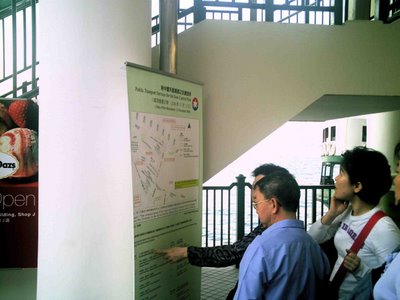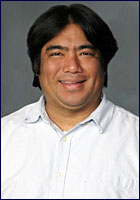More on the Star Ferry tower
I went to the Star Ferry pier again today to take pictures of the demonstrations.
First, though, I want to show you the time progression in photos of the demolition of the tower. It's not perfect, because I never had a picture of the clock tower in its original glory. But the protesters had such pictures, so first I have a picture of that. Next there's the same picture I gave last time of the clock tower with scaffolding around it. Then there's a picture I took today where the clock tower is missing. It's been demolished. The shot is not the same angle as the one I took last time because quite frankly I forgot where I shot it from. This one turns out to be more face-on, while last time it was at a sharp angle.



Now for the demonstrations. Last time I said it was about a couple dozen, because that's what the newspaper article said. A later news article said there were more like 100 demonstrators. When I was there (3 pm) it was definitely more than 100 people, though some of that could have been curious onlookers.






They had a panel of people talking about different things. I randomly ran into someone who works at the HKBU International Office, so she told me that the speaker was saying that this shows the need for real democracy in Hong Kong.

But still the work goes on. There's a hole in the corrugated metal that allowed a view of the actual destruction.


I got a flyer from one of the demonstrators. It mentioned that this clock tower was in fact the site of a hunger strike against the British in 1966. And now, the irony is, the very clock tower is the focus of demonstrations against the Hong Kong government, or in its words:
At the moment that the Clock-Tower ... is being murdered, we begin our hunger-strike... against the Hong Kong SAR Gov't, the so-called "Ruled by Hong Kong People" and "For the people" one.
It goes on:
Someone may say, we are too late. We say, the opposing voice have never stopped. Professionals ... have prepared alternative plans but the gov't does not listen... We can only use the most fundamental weapon of the people, our body to resist the black hand behind the bulldozer.
It seems that this is a focal point for people who want real democracy to come to Hong Kong. Universal suffrage. Free elections. The flyer goes on:
Let Cultural Heritage and Public Space of Hong Kong People return to democratic discussion procedures.
We demand real "For The People".
We want to be Real Hong Kong People and our Real Hong Kong Culture.
If this is supposed to be a touchstone for the burgeoning democracy movement, I don't know how effective it's being. The government realizes now that many Hong Kong people feel they have gone too far. But only 100 or maybe 200 people are here. They're not really disrupting anything. Most Hong Kong people I've talked to are sad to see the clock tower go. But most of them are not at the protest.
Out with the old
Someone was visiting Hong Kong from Germany recently, and asked me about where to find old buildings.
There basically aren't any, really. Certainly not for European standards.
For that, go to Xi'an in the middle of mainland China. That was the capital of China for centuries, and by those standards, Beijing is a newcomer, being the capital of China for only 700 years.
Hong Kong was a backwater town with nothing of note when the British took over after the first Opium War in the 1840s, and only grew when persecution in China caused many Chinese to flee here. You'd be hard pressed to find any building that even dates from the 19th century, because Hong Kong has never been a fan of preserving their history.
Go to Macau, a Portuguese colony a short boatride away, and there's colonial architecture going back 400 years. But in Hong Kong, the colonial architecture was taken down to make room for skyscrapers.
In fact, when the Bank of China decided to build its landmark skyscraper, they decided to tear down the earliest colonial building in Hong Kong, Murray House, to do it. Some people protested, and the government ordered that Murray House be dismantled and built somewhere else. They dismantled it, quickly built the Bank of China building, then decades later finally got aroudn to rebuilding Murray House in Stanley, where the British live. There are still six columns that are left over that they don't know what to do with.
Well, this year, the big news is they are tearing down the Star Ferry pier. The Star Ferry is a common way to get from Kowloon to Hong Kong island, and has two piers on the Kowloon side, and two piers on the Hong Kong side. The best-known one is Edinburgh Place on the Hong Kong side. It has a clock tower and is a Hong Kong landmark.
Well, they're tearing it down to build a shopping mall. The Star Ferry now docks at Central Pier, which is about a block away.
Welcome to Hong Kong, where your Lonely Planet guide is obsolete by the time it makes it off the printing press.
Here's Edinburgh Place, with scaffolding as they prepare to demolish it:

This is the side that faces inland. The tower in the middle has a clockface that they're removing.

The Star Ferry now docks at Central Pier:


And now locals, upon arriving at the pier by the Star Ferry, are a bit confused as to how to get to where they need to go:

Well, not all of Hong Kong is happy about the demolition. There have been protests. A couple dozen people are trying to stop the bulldozing, and a few people have been arrested. Still, the Chief Executive Donald Tsang says the demolition will continue. Maybe the clockface will be incorporated into the design of the shopping mall, he says.
A Student Video
Sean Bartemes, one of the exchange students at Hong Kong Baptist University (not from Pepperdine but from the US) is studying film, and for one of his classes, did a short. It's on Youtube now. Check it out:
The Hong Kong JobYes, that is exactly what happens at Hong Kong Baptist University. Send your students here and that is the kind of thing they will get into. Just kidding. But Sean did a good job, I think.
Taikonauts and Nazis
The US space program had lots of help from European-trained engineers who fled or were forced out of top positions by the Nazis during World War II. Before this, the United States had lots of production capacity, but little in the way of technical scientific expertise. The US, being practical-minded, never invested a great deal in basic research, unlike Germany, France, and other European nations who saw basic science as an end in itself.
When the Nazis took over, they made a point to kick out of academic posts and government positions those whose views or race they saw as suspect. Many of these people fled to the US, where they helped in the war effort and later, the Cold War and the Space Race.
I bring this up because I just read an article in the South China Morning Post about China's race to the moon. In it, one man features prominently: Tsien Hsuehshen (Qian Xueshen). He is basically the father of China's space program. And get this: he got his start by getting kicked out of the US during the McCarthy period. Here's what The Economist says, in an article from April 11, 2002, "Taikonauts are go":
China's space programme was unwittingly spurred by the Americans. Nearly 100 scientists of Chinese ancestry were thrown out during the McCarthyite era and sent to the recently formed People's Republic. One of them was Tsien Hsueshen, an aeronautical engineer who was an expert in the new technology of jet propulsion. In 1956 he became head of China's new missile programme.
Dr Tsien's team, working initially with Russian help and then—after the rupture of relations between the Soviet Union and the People's Republic in 1959—on its own, built up a secretive but successful operation. It was based, like the Soviet and American programmes, on knowledge gleaned from Germany's second-world-war V-2 missile project. Before the rupture, the Russians gave China a slightly improved version of the V-2, known as the R-2, and the team took it to pieces to find out how it worked. By the time the Russians had left, Chinese engineers were expert enough to strike out on their own. Within a few months, they had successfully launched their first home-grown R-2, known as Dong Feng (East Wind).
Paranoia has a nasty self-defeating effect.


















